《1 Introduction》
1 Introduction
Critical basic materials are essential for advanced industrial products and their production processes, and are the basis for the development of advanced manufacturing. Critical basic materials include but are not limited to materials which have a large number and wide range of applications but still need improvement, independently developed materials which affect economic security and national defense, and novel materials which lead to the development of advanced manufacturing and must be acquired in advance. The critical basic materials described in this paper include electronic information materials, new energy materials, novel chemical materials, new construction materials, steel materials for high-end heavy equipment, high-performance nonferrous and rare metal materials, inorganic non-metallic materials, special fiber materials, and biomedical and pharmaceutical materials.
In general, China’s critical basic materials have made great progress after years of development. In addition, the level of core technology has improved significantly and the scale of industry has been expanded gradually. This development has provided strong support for the development of the national economy and construction of the national defense industry. However, the competitiveness of critical basic materials must be improved, as the product quality and reliability hardly meet the demand, and hence, dependence on imported critical material continues [1]. Therefore, it is necessary to strengthen the top-level design of critical basic material development and improve related policies and measures. This has important strategic significance for implementing the Made in China 2025 strategy, upgrading China’s basic industrial capabilities, strengthening the defense industry, and accelerating the transformation of the economic development mode.
《2 Development status of China’s critical basic materials》
2 Development status of China’s critical basic materials
《2.1 constant improvement on macro policy environment for critical basic materials》
2.1 constant improvement on macro policy environment for critical basic materials
Recently, the State Council, National Development and Reform Commission, Ministry of Industry and Information Technology, and Ministry of Science and Technology have issued a number of macro industrial development plans, such as the Decision of the State Council on Accelerating the Cultivation and Development of Strategic Emerging Industries, The 13th Five-Year Plan for Strategic Emerging Industries Development, Made in China 2025, Key Technology Roadmap of Made in China 2025, Industry Strength Foundation Project Implementation Guide (2016-2020), Guiding Opinions on Accelerating the Innovation and Development of New Material Industry, and The 13th Five-Year National Science and Technology Innovation Plan (Table 1) [2]. Moreover, these departments have issued specific development plans for different areas and further clarified the goals and tasks for critical basic materials development. These goals and tasks pertained to specific products, technologies, and equipment and have been implemented in major projects which lay the foundation for corporate decisions, government allocation of public resources, and healthy development of strategic emerging industries.
《Table 1》
Table 1. China’s critical basic materials industry development plans.
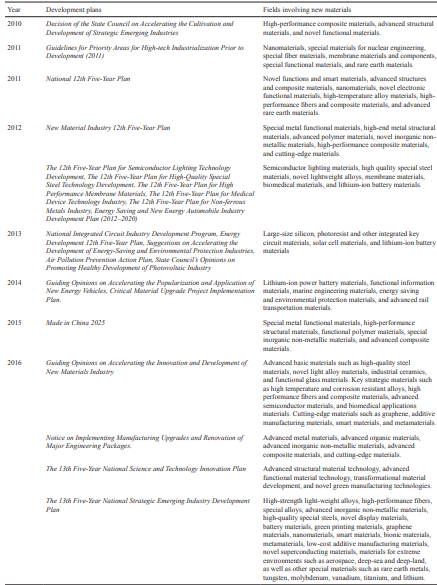
《2.2 Improved research level of critical basic materials》
2.2 Improved research level of critical basic materials
The key to promoting industrial strength and improving competitiveness is improving the capacity for independent innovation and strengthening core technological breakthroughs. With production, education, and research over the last 20 years, breakthroughs in a large number of critical basic materials’ core technologies have been achieved, and these R&D achievements have been promoted and applied. These achievements significantly improved the core competitiveness of fields related to critical basic materials [2]. Large-diameter silicon materials continue to improve in terms of defects, geometric parameters, particles, and impurity control technologies. Dislocation-free 450 mm silicon monocrystalline material has been developed, and 300 mm silicon material could meet integrated circuit requirements for 45 nm nodes used in next-generation technologies [3]. Progress has also been made in artificial crystal materials over the last few years. The development of ultraviolet non-linear optical crystals, such as barium metaborate (BBO) and lithium triborate (LBO), has reached an advanced level and achieved commercialization internationally. Potassium fluoroborate (KBBF) is the only practically available deep-ultraviolet non-linear optical crystal to date that has been equipped successfully in advanced scientific instruments in China. The major technical advances in laser crystal technology such as for Nd:YAG, Nd:GGG, and Nd: YVO4 lasers, have reached an advanced international level and a kilowatt-class all-solid-state laser output has been produced [4]. Lithium-ion battery cathode/anode materials and electrolytes have been developed to meet the requirements of small batteries. In addition, local development of other key materials such as separators, electrolytes, and lithium salts have decreased the reliance on imports. The development of industrial materials, such as ultra-high molecular weight polyethylene fibers, halogenated butyl rubber, and high-performance flooding polymers, has narrowed the gap between China’s chemical materials industry and those of developed countries. Submarine pipeline steels (X65, X70, and X80), thick-wall marine oil and gas pipelines, and chemical medium-strength plates are examples of advanced materials that have been domestically produced. The independently developed 2205 duplex stainless-steel has been used in chemical vessels. In addition, 9 % Ni steel has been used in liquefied natural gas ships and 12Ni19 steel for liquefied ethylene storage tanks has been mass produced. Next-generation aluminum alloy materials with high strength, toughness, and hardenability and rapidly solidified spray-deposited aluminum alloy materials with strength greater than 800 MPa have achieved excellent performance on an international level [5]. Value-added preparation technologies for copper materials such as copper strips, brass casts, and copper-aluminum composites have been developed and patented. The performance of submicron ultrafine carbide cutting tools has also reached a world-class level. Steel with yield strength of 355 MPa is domestically produced and accounts for 90 % of the steel used in steel platforms. Significant progress has been made in the development and production of large titanium alloy ingots and forgings, and the technology for titanium alloy material development and processing of large-size titanium alloy materials has significantly improved [6]. C194, KFC, and C7025 electronic lead frame copper tapes represent key technological breakthroughs for industrialization and have reached a 10,000-ton production scale. Stable production of T300-grade carbon fiber has been achieved with increased single-line production capacity of 1200 tons, and T700-grade high-performance carbon fiber is now produced using the dry-jet wet spinning process. The key equipment for these processes has been independently designed and manufactured, which has significantly reduced production costs of these materials. The performance of basalt fiber, polyphenylene sulfide fiber, and other products has reached an advanced level. China issued the National Standard for Electromagnetic Metamaterials and developed a new satellite communication product based on metamaterials and super-radio technology, as shown in Fig. 1. Two-dimensional materials, such as graphene-related materials, have been used in the applications shown in Fig. 2 [7,8].
《Fig. 1》

Fig. 1. Metamaterials and their uses.
《Fig. 2》
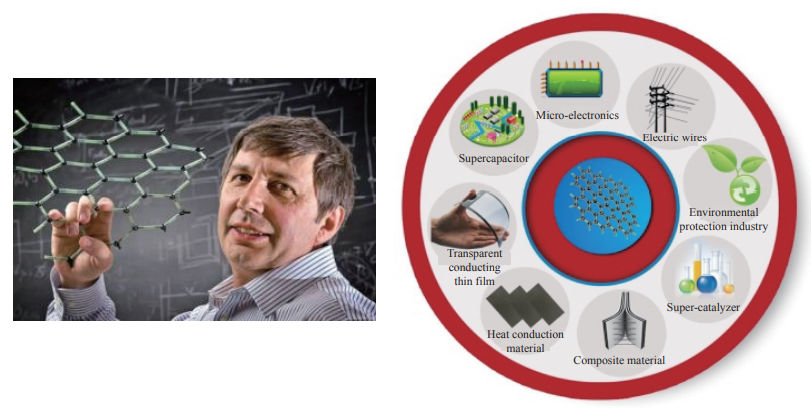
Fig. 2. Graphene-related materials and their use.
《2.3 Rapidly expanding production of critical basic materials》
2.3 Rapidly expanding production of critical basic materials
In recent years, the new materials industry has rapidly developed as a strategic emerging industry. The industry scale has grown from 650 to 25,000 billion yuan from 2010 to 2016 (Table 2), with an average annual growth rate of approximately 25% [9]. Among the key basic materials, the output of rare earth metals ranks first in the world, with a total export volume of 47,227 tons in 2016, a year-over-year increase of 35.6 % [10]. The output value of semiconductor silicon materials reached 5.3 billion yuan in 2015, which was a 60 % increase compared to 2010 and accounted for approximately 5 % of the global market share. The research and application of membrane materials has developed rapidly. The total output value of the membrane treatment industry reached 84.9 billion yuan in 2015, an increase of 15.8 % over that of 2014 [11]. The photovoltaic power generation industry continues to grow and new installed capacity reached 34.54 GW, with a cumulative installed capacity reaching 77.42 GW in 2016, which both ranks first worldwide [12]. The semiconductor lighting industry has developed a relatively complete R&D and industrial system, from upstream epitaxial material production and chip manufacturing to midstream device packaging and downstream integrated applications. The output value of the semiconductor lighting industry reached 521.6 billion yuan in 2015, a year-over-year increase of 22.8 % [13]. The scale of biomedical materials and products continue to grow with market sales reaching nearly 144 billion yuan in 2015, with an annual growth rate exceeding 17.2 % [14]. The output of steel, as an indispensable pillar material in construction, was 1.138×109 tons in 2016, a year-over-year increase of 2.3%. Special steel production increased by 10.52 % compared to the same period last year. The total output of non-ferrous metals reached 5.283×107 tons, a year-over-year increase of 2.46 %. Among them, the output of copper and aluminum reached 2.095×107 and 5.796×107 tons, a year-over-year increase of 12.53% and 9.72%, respectively.
《Table 2》
Table 2. China’s new material industry scale from 2010 to 2016.
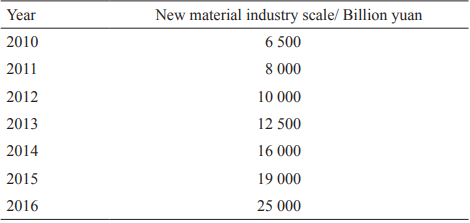
《2.4 Emerging role of critical basic materials for important national strategies》
2.4 Emerging role of critical basic materials for important national strategies
With further improvements in environmental protection and the requirements for green and low-carbon processes, China has implemented a strategy for energy conservation and emission reduction to gradually change the traditional model of high input, consumption, pollution, and low efficiency. China has made unremitting efforts to increase the efficiency of resource and energy use and reduce environmental pollution in manufacturing processes [15]. In the process of industrial transformation, the production of critical basic materials has been adjusted and the development of environmental-friendly materials has been increasing. The use and promotion of lightweight structural materials such as aluminum, titanium, and magnesium have become increasingly prominent in the energy, resource, and environmental industries. Self-developed high efficiency and energy-saving aluminum electrolytic tanks with novel cathode structures have greatly reduced energy consumption and made outstanding contributions to energy conservation. Key technical issues concerning special steel production have been overcome, solving the problems associated with the production process and significantly reducing unit production costs [16,17]. Carbon fiber composite materials have been applied in the aviation, which effectively reduced equipment weight, fuel consumption, emissions, and operating costs [18]. A next-generation chemical fiber recycling system characterized by high quality, multi-functionality and low energy consumption has been established through recycling technology innovation. Recycling systems for waste textiles and plastics have been continuously developed and improved. Chemical fiber regeneration and recycling as well as raw material composition have been refined, which has increased the ratio of high-quality recycled textiles.
Critical basic materials have made significant contributions to the smooth implementation of major projects to improve people’s livelihood, environmental protection, and develop next-generation information technology. A new building material industry has developed in the model combining self-development with national major projects, which provide important support for green buildings, building energy conservation, old city reconstruction, housing projects, new rural construction, disaster prevention and reduction, and post-disaster reconstruction [19]. Novel energy materials, such as nickel-metal hydride batteries, lithium-ion power batteries, and fuel cells, have provided technological advancement, which has promoted the development of electric vehicles. Electric vehicles were used in the 2008 Olympic Games, the Shanghai World Expo, and the Ten Cities Thousands Electric Cars Project, which demonstrated the development of new energy sources with the potential to reduce environmental pollution [20]. Microelectronics technology continues to improve, which has effectively supported the smooth implementation of major scientific and technological projects during the 12th Five-Year Plan, and promotes the healthy domestic development of integrated circuits and information industries. The steel industry has combined research, development, production, and application and has overcome a number of technical difficulties. The strength, toughness, and plasticity of steel have been continuously improved. The varieties and quality of major high-end steels have effectively supported the development of major national projects and high-end equipment manufacturing, as shown in Fig. 3 [21,22].
《Fig. 3》
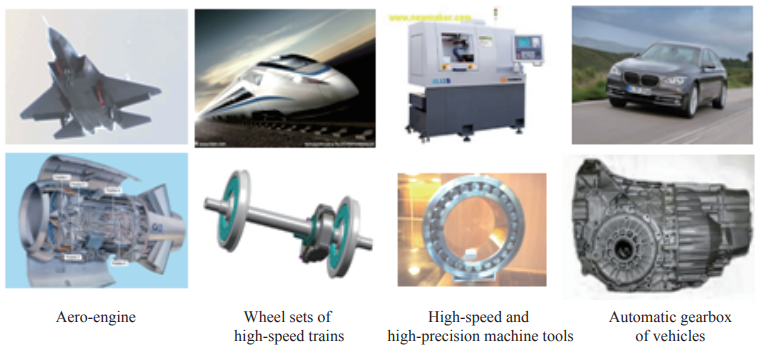
Fig. 3. Typical application of critical steel materials.
Although significant progress has been made in the research, development, and industrialization of critical basic materials in China, a large gap remains between China and developed countries, and there are still some contradictions and problems in commonly used development processes [23,24]. First, original innovation capacity is insufficient, and the basic support system is not perfect. China’s critical basic materials have not been incorporated into material brands and systems with independent intellectual property rights. National and industrial standards for basic raw materials, design specifications, and material process quality control are also incomplete. In addition, an industry-standard open database for material structure design, manufacturing, and evaluation has not been developed. Common technology R&D capability is not strong, and the self-sufficiency rate of high-end products is insufficient. In most industries in China, common technology R&D is absent. Common and frontier technology R&D lacks proper resources and continuous effective investment, making it impossible to support independent technology innovation. The lack of R&D has become a bottleneck that restricts the adjustment and upgrading of China’s industrial structure and has decreased industrial competitiveness. In addition, the top-level design and overall coordination is lacking, and instead low-level redundant construction is more common. Although a large amount of material industry plans from the national to local level have been released, some regions have not considered their own conditions and advantages and have not made scientific advances or reasonably positioned themselves for efficient labor division. In some industrial fields, serious convergence phenomena including homogenous layouts, mainline-missing development, and low-level competition swirl exist [2]. The distribution of resources is fragmented, and the industrial chain is incomplete. At present, the number of key basic material enterprises in China is large but scattered. The number of backbone enterprises with international competitiveness is small, the level of industry scale benefits is low, price control ability is weak, and access to the international market needs improvement. Some critical basic material industry supply chains are missing, coordination and supporting services are delayed, and the trend of agglomeration development has not been formed. Upstream development lags behind, and downstream applications face tremendous upgrade pressure. In addition, links between upstream and downstream industries are not smooth, which is detrimental to the healthy development of the critical basic material industry. The concept of green and low-carbon industry is also weak, and energy saving and environmental protection must be strengthened. Some critical basic material manufacturers in China have weak green and low-carbon concepts and only care about development with low investment, short cycles, and rapid benefits, which often leads to low-end products, enormous waste, and severe environmental pollution.
《3 Development of foreign critical basic materials》
3 Development of foreign critical basic materials
《3.1 Macro guide to critical basic materials》
3.1 Macro guide to critical basic materials
Since the beginning of the 21st century, countries around the world have paid close attention to critical basic materials. They have formulated corresponding plans and issued policies regarding R&D, markets, and industrial environments to comprehensively strengthen and promote the development of critical basic materials [2]. More than 20 developed countries and emerging economies have developed material-related emerging industry development strategies and have initiated more than 100 special programs. The United States released the Strategy for American Innovation in 2009 and updated it in 2011 and again in 2015. One of the six key elements in this strategy for sustaining the innovation ecosystem is catalyzing breakthroughs for national priorities by promoting clean energy technologies and advancing energy efficiency, tackling grand challenges, targeting disease with precision medicine, reducing fatalities with advanced vehicles, building smart cities, developing breakthrough space capabilities, and pursuing new frontiers in computing. These strategic objectives all involve critical basic materials. The European Union (EU) formulated the Europe 2020 Strategy in March 2010 to emerge stronger from the economic and financial crisis, meet global challenges, and turn the EU into a smart, sustainable, and inclusive economy delivering high levels of employment, productivity, and social cohesion. Europe 2020 puts forward three mutually reinforcing priorities: smart, sustainable, and inclusive growth. Germany released the 2020 High-tech Strategy for Germany: Idea·Innovation·Growth in 2010. The United Kingdom Department for Business, Innovation, and Skills (BIS) released the Innovation and Research Strategy for growth in 2011. Japan released the New Growth Strategy based on the Economic Revival Strategy in 2015. South Korea released the National Strategy for Green Growth, Five-Year Action Plan, and the New Growth Power Planning and Development Strategy in 2009. Besides these strategies, countries all over the world have also developed special plans and action plans to support priority areas. The United States, EU, and Japan have launched special plans such as the Smarter Planet, the Federal Big Data Research and Development Strategic Plan, the Internet of Things Strategic Research Roadmap, the UK Digital Strategy, and the ICT Hatoyama Plan. Emerging economies such as Brazil, India, and Russia have adopted catch-up strategies and are developing special plans for new energy materials, energy-saving and environment-friendly materials, nanomaterials, biomaterials, medical and health materials, and information materials [25] to seize a place in the future international competition. The above plans all regard critical basic materials as a key development direction, development area, and important aspect of industrial development and use critical basic materials as an important support for the next industrial revolution (Table 3).
《Table 3》
Table 3. International critical basic materials related development strategies and plans.
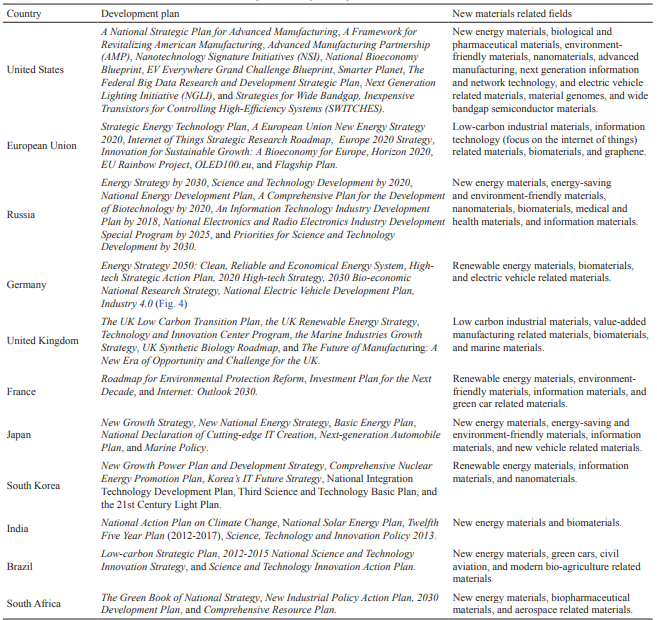
《Fig. 4》

Fig. 4. Industry 4.0
《3.2 Critical basic material technology development breakthrough to promote industrial transformation》
3.2 Critical basic material technology development breakthrough to promote industrial transformation
The rapid development of high-tech industries promotes the development of critical basic materials, and vice versa [2]. Silicon has played an important role in continuous cost reduction, chip integration, and information-processing speed increase. Currently, the 300 mm silicon chip can meet the integrated circuit requirements of the 14 nm nodes, and has good long-term development prospects (Fig. 5) [26]. The promising 450 mm silicon chip samples has also been produced. The important R&D breakthrough of low-temperature co-fired ceramic (LTCC) technology has made integrating large passive electronic components in the same substrate possible [27]. To date, the LTCC technology has mainly been used as an interconnected packaging method for multi-chip modules (MCM/C), but it can also be used in non-circuit applications such as fuel cells, sensors, and electronic components. Over the past few decades, an increasing number of industries have emerged with the continuous extension of advanced materials technology research. For example, the development of compound semiconductor materials, including gallium nitride, has given rise to semiconductor lighting technology [28]. White light-emitting diodes (LEDs), which have far more luminous efficacy than incandescent or fluorescent lamps, have brought revolutionary changes to the lighting industry. The continuous improvement of solar cell conversion efficiencies has greatly promoted the development of new energy industries. High-tech structural materials, such as magnesium and titanium alloys, have achieved breakthroughs in processing technology with continuous cost reductions, which has expanded the research and application focus from aviation, aerospace, and military fields to value-added residential applications [29–32]. The development of clinical diagnostic materials and devices based on molecules and genes has made the early detection and treatment of major diseases possible, such as liver cancer. The R&D of interventional devices has generated minimally invasive and interventional techniques, which have significantly reduced the death rate from cardiovascular diseases [33,34].
《Fig. 5》
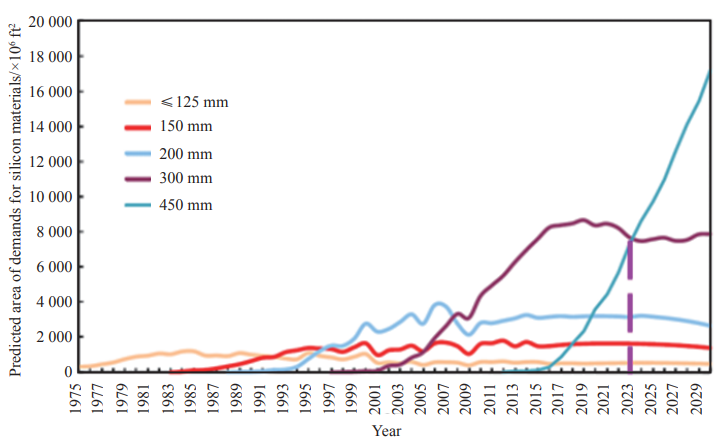
Fig. 5. Silicon materials demand predication.
《3.3 Green processes and low carbon intensity as important standards for critical basic materials development》
3.3 Green processes and low carbon intensity as important standards for critical basic materials development
The rise of new renewable energy, such as solar, nuclear, and bio-energy, has caused major changes in power, construction, automotive, and communications industries [35,36]. This has led to the development of a series of manufacturing and resource processing industries, including wind turbine manufacturing, photovoltaic modules, and poly-silicon industries. Over the long term, these industries can promote the development and production of transportation and terminal products, such as smart grids and electric vehicles. Developed Western countries have passed legislation to promote the development of energy-efficient buildings and photovoltaic power generation. At present, 80 % of the insulated glass in Europe uses Low-E glass, with the penetration rate of Low-E glass in the United States reaching 82 % [37]. The energy saving principle of Low-E glass is described further in Fig. 6. Enhancing structural material toughness and temperature adaptability, extending material life, and implementing material composite design can reduce costs and increase material quality. For example, T800 carbon fiber has a compressive strength (CAI) of 350 MPa can be used at temperatures above 400 °C, which has opened a large number of applications in the main structural parts of large aircraft and missiles. Functional materials have also been developed towards miniaturization, multi-functionalization, module integration, and intelligence to improve material performance [38]. The fusion of nanotechnology and advanced manufacturing technologies will result in smaller, smarter, more integrated, and more functional products.
《Fig. 6》
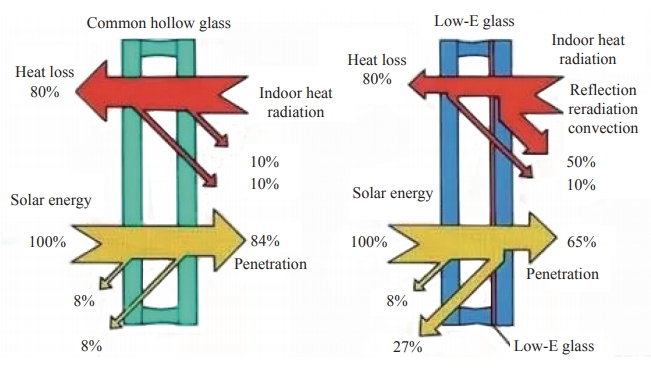
Fig. 6. Energy saving principles of Low-E glass.
《3.4 Changing the R&D model of critical basic materials》
3.4 Changing the R&D model of critical basic materials
Since the beginning of the 21st century, developed countries have gradually realized that traditional material research methods which rely on trial and error cannot keep up with the rapid pace of industrial development, and may even become a bottleneck restricting technological progress. Therefore, an urgent need has arisen for innovative material R&D methods to accelerate the progress from R&D to application. The U.S. government launched the Material Genome Initiative (MGI) in 2011 as an important part of the Advanced Manufacturing Partnership (AMP). The MGI aims to decrease the time and cost of material discovery to deployment, develop high-end manufacturing based on advanced materials, and maintain the American advantage in core science and technology [39–41]. The four MGI strategic goals are: 1) enable a paradigm shift in materials development and use; 2) integrate experiments, computation, and theory; 3) facilitate access to materials data; 4) equip the next-generation materials workforce. An analogy between the MGI and Human Genome Project is shown in Fig. 7. Besides the United States, other countries have initiated similar scientific plans to reform the material R&D model. The EU launched the Accelerated Metallurgy (ACCMET) program in response to the demand for high-performance materials such as lightweight, high-temperature superconducting, magnetic, thermomagnetic, thermoelectric, and phase change memory storage materials [2].
《Fig. 7》
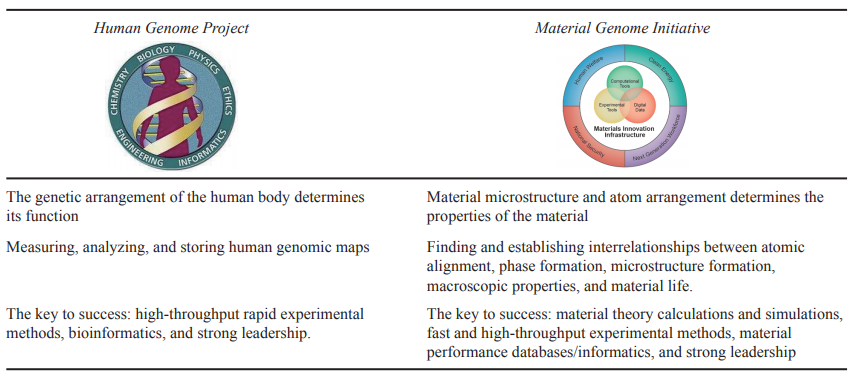
Fig. 7. Analogy between the Material Genome Initiative and the Human Genome Project
《4 Development focus of China’s critical basic materials》
4 Development focus of China’s critical basic materials
According to the international development trends as well as the demands of China’s growing economy and national defense industry, China has selected key critical basic materials and aims to accelerate major technological breakthroughs, create a suitable environment for industrial development, promote industrial upgrading, and form good industrial ecology.
《4.1 Development goals》
4.1 Development goals
4.1.1 Development goals by 2020
China’s critical basic materials development goals by 2020 are as follows: 1) master the core technology, achieve breakthroughs with respect to large-scale production technology, improve system integration technology, and shorten the gap with the world leaders; 2) establish a high-level business-oriented material R&D platform and strengthen engineering technology research; 3) promote the localization of critical basic materials and achieve a 70 % self-sufficiency rate; 4) ensure mass production to meet the needs of major national projects and national security.
4.1.2 Development goals by 2025
China’s critical basic materials development goals by 2025 are as follows: 1) make the overall critical basic materials industry achieve the world leaders’ level; 2) achieve large-scale green manufacturing and recycling; 3) build a critical basic materials innovation system and achieve self-sufficiency in the supply of most critical basic materials; 4) meet the needs of the national economy, national security, and socially sustainable development; 5) achieve the transition from quantity to quality.
《4.2 Development priorities》
4.2 Development priorities
The development priorities of critical basic materials are summarized in Table 4.
《Table 4》
Table 4. Development priorities of critical basic materials.

《5 Policy suggestions for accelerating the development of China’s critical basic materials》
5 Policy suggestions for accelerating the development of China’s critical basic materials
《5.1 Accelerate the R&D system》
5.1 Accelerate the R&D system
We should closely follow the national development strategy, strengthen top-level design, and rationally design the R&D system for critical basic materials, paying attention to the cutting-edge materials in the R&D stage, making appropriate arrangements for advancement, establishing an industry-standard open database for material structure design, manufacturing, and evaluation, developing a material standard system with Chinese characteristics which is also in line with international standards, and addressing the engineering problems in the development of critical basic materials industries.
《5.2 Improve the industrial development environment》
5.2 Improve the industrial development environment
We should accelerate the formulation of guidance catalogs and investment-oriented opinions regarding the development of key basic materials industries and improve the industrial, innovation, and capital chains. Exerting the role of market allocation of resources, scientific guidance, and rational investment should be emphasized. Coordination of the country’s focused support for key basic materials industries should be highlighted to assist in the healthy growth of small- and medium-sized enterprises producing critical basic materials and create an industrial ecological environment with international competitiveness.
《5.3 Promote the coordinated development of quality and efficiency》
5.3 Promote the coordinated development of quality and efficiency
We should improve the product quality and stability of critical basic materials, reduce production costs, and enhance industrial support capabilities. Focusing on the country’s major project construction needs, we should strengthen collaborative innovation in production, education, and research, and improve the consistency and service reliability of key basic materials. Promotion of supply chain establishments and collaboration between advantageous critical basic material companies and highend equipment manufacturing enterprises should be emphasized. In addition, the optimization of a variety of structures, promoting product integration into global high-end manufacturing supply chains, and improving the international competitiveness of critical basic materials in China are essential.
《5.4 Strengthen policy support》
5.4 Strengthen policy support
We should increase financial and taxation policies to support critical basic materials, establish and improve standardized risk investment operations, risk aversion, and exit mechanisms, and form a healthy system that encourages domestic use of critical basic materials. In addition, improving tax policies that support innovation and creating a good investment environment to prevent a wholesale invasion of investment and the phenomenon of investment overlapping are important. Implementing the deduction of R&D expenses and preferential income tax policy for high-tech enterprises is also essential.
《5.5 Promote talent team construction》
5.5 Promote talent team construction
We should implement innovative talent development strategies, foster core talents and teams, encourage talent at home and abroad, and promote enterprises to actively cultivate independent innovative talents. At the same time, we should also support the role of industry associations, research institutes, and universities, and jointly establish a key basic materials industry expert system to strengthen direct communication and exchange of material R&D, production, and application of knowledge. The critical basic materials industry expert system should provide advice on the status quo, development trends, and key issues of concern for the key basic materials.

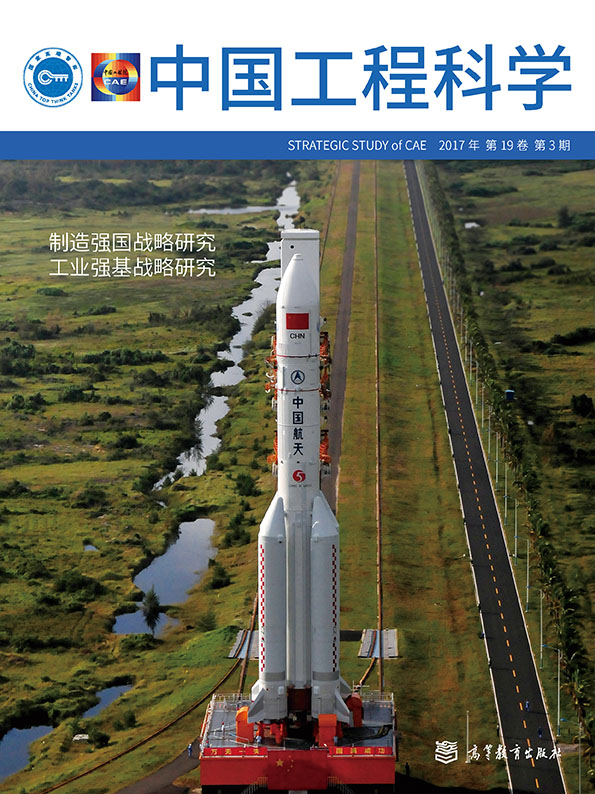












 京公网安备 11010502051620号
京公网安备 11010502051620号




